Bayan Shireh Formation
The Bayan Shireh Formation (also known as Baynshiree/Baynshire Formation or Baynshirenskaya Svita) is a geological formation in Mongolia, that dates to the Late Cretaceous period. It was first described and established by Vasiliev et al. 1959.[1]
| Bayan Shireh Formation Stratigraphic range: Cenomanian-Santonian ~96–89 Ma | |
|---|---|
Fossil localities in Mongolia. From C to D, mainly Bayan Shireh locations | |
| Type | Geological formation |
| Sub-units | Upper Bayan Shireh, Lower Bayan Shireh, "Sheeregeen Gashoon" beds |
| Underlies | Javkhlant Formation |
| Overlies | Sainshand Svita |
| Thickness | Up to 300 m (980 ft) |
| Lithology | |
| Primary | Claystone, sandstone |
| Other | Conglomerate, mudstone |
| Location | |
| Coordinates | 44.3°N 109.2°E |
| Region | Gobi Desert |
| Country | |
| Type section | |
| Named for | Bayan Shireh |
| Named by | Vasiliev et al. |
| Year defined | 1959 |
Geology
The Bayan Shireh Formation is primarily composed by varicoloured claystones and sandstones with calcareous concretions and characterized by grey mudstones and yellowish-brown medium grained sandstones.[1][2] Up to 300 m (980 ft) thick, the most complete sections are found in the eastern Gobi Desert, consisting of fine-grained, often cross-stratified gray sandstone interbedded with claystone and concretionary, intraformational conglomerates with relatively thick units of red to brown mudstone in the upper part.[3][4] The Baynshire and Burkhant localities are mainly composed by mudstone, siltstone, sandstone, and conglomerates, with most of their sedimentation being fluvial.[5][6][7] The environments that were present on the Bayan Shireh Formation consisted mainly on semi-arid climates with large water bodies, such as rivers or lakes.[8][7] Although it is considered to be partially lacustrine[9], largescale cross-stratification in many of the sandstone layers at the Baynshire locality seem to indicate that a large meandering fluvial system was present. The upper Bayan Shireh Formation is marked by a horizon of large concretions, mudstones and concretionary conglomerate. It has been implied that during the late Bayan Shirehnian times, large rivers with direct connections to the sea drained a prominent part of the eastern Gobi region.[3][6][8]
While the lower Bayan Shireh is composed by extensive conglomerate that indicates the ancient presence of very active rivers, the upper Bayan Shireh is mainly composed by mudstone and claystone that is interbedded by sandstone, indicating again, the presence of rivers but also lakes and other water bodies.[10]
Stratigraphy
At first, the exact age was uncertain: based on comparisons with other formations, the Bayan Shireh paleofauna seems to correspond best with the Turonian through early Campanian stages of the Late Cretaceous, about 93 to 80 million years ago.[5] However, examination of the magnetostratigraphy of the formation indicates that the entire Bayan Shireh lies within the Cretaceous Long Normal, which lasted only until the end of the Santonian stage, giving a possible Cenomanian through Late Santonian age, between 98.5 and 83.5 million years ago.[6] In 2012, Averianov and Sues re-examined many formations from the Gobi Desert, also the Bayan Shireh Formation. Based on biostratigraphic occurrences and previous dating, the Bayan Shireh Formation was again dated to the Cenomanian-Santonian stages, between 97.8 million and 83.6 million years ago. The upper Bayan Shireh dating to 90.5 million and 83.6 million years ago (Late Turonian-Late Santonian) correlating the Iren Dabasu Formation, and lower Bayan Shireh dating to 97.8 million and 90.5 million years ago (Early Cenomanian-Late Turonian).[8]
Based on the notorious turtle abundance among dinosaur remains, Danilov et al. 2014 considered the lower beds to be Cenomanian-Early Turonian and the upper beds to be Late Turonian-Santonian in age.[11] The recent redate of the formation, based on calcite U–Pb measurements, has estimated the exact age of the Bayan Shireh Formation from 95.9 ± 6.0 million to 89.6 ± 4.0 million years ago, Cenomanian trough Santonian ages.[12]
Correlations
A potential correlation between the Iren Dabasu Formation has been long suggested by most authors, mainly based on the highly similar vertebrate assemblages.[5][13][14][15] However, Van Itterbeeck et al. 2005 argued against this correlation concluding that instead, the Iren Dabasu Formation was coeval with the younger Nemegt Formation based on the charophyte and ostracode assemblages; therefore, these formations were dated to the Late Campanian-Early Maastrichtian.[16] Averianov and Sues found that this correlation was inconsistent since the microfossil assemblages used by Van Itterbeeck and colleagues were not restricted to the Maastrichtian period and the similarities between these assemblages were most probably due to a similar deposition and climate settings. They proposed a correlation between the Bayan Shireh, Iren Dabasu and Bissekty Formations.[8]
Fossil content
In terms of biodiversity, therizinosaurs and turtles were the most abundant vertebrates across the formation, as evidenced on numerous remains.[11][17] Nevertheless, hadrosauroids were pretty abundant too, particularly at the Baynshire locality with numerous remains unearthed from this area and a new unnamed hadrosauroid. In addition, most specimens of Gobihadros come from this locality.[7][18][10] Also, niche partitioning has been reported within the therizinosaurs Erlikosaurus and Segnosaurus[19], and the ankylosaurs Talarurus and Tsagantegia.[20] Mammals however, are extremely uncommon; Tsagandelta is the only mammal described so far.[21] Besides vertebrate fossils, abundant fossil fruits have been collected from the Bor Guvé and Khara Khutul localities, suggesting the presence of Angiosperms, they are specially abundant at Bor Guvé. Although they resemble Abelmoschus esculentus their taxonomic position remains unclear and further examination is required.[22]
Color key
|
Notes Uncertain or tentative taxa are in small text; |
Dinosaurs
Theropods
| Theropods reported from the Bayan Shireh Formation | ||||||
|---|---|---|---|---|---|---|
| Genus | Species | Location | Stratigraphic Position | Material | Notes | Images |
| A. giganticus | Burkhant, Dornogovi Province |
Upper Bayan Shireh |
"Maxilla and fragmentary postcrania."[23] |
A giant dromaeosaurid. |
 | |
| A. olseni | Bayshin Tsav, Ömnögovi Province |
Upper Bayan Shireh |
"Two specimens, fragmentary skull and postcrania."[24] |
A tyrannosauroid. Also present in the Iren Dabasu Formation |
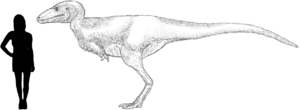 | |
|
Dendroolithidae spp. |
Indeterminate |
Baynshire, Dornogovi Province |
Upper Bayan Shireh |
Eggs nests attributed to the Dendroolithidae. |  | |
| E. mongoliensis | Khara Khutul, Dornogovi Province |
Lower Bayan Shireh |
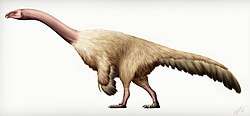 | |||
| E. andrewsi | Bayshin Tsav, Ömnögovi Province |
Upper Bayan Shireh |
A therizinosaur. |
 | ||
| G. brevipes | Bayshin Tsav, Ömnögovi Province |
Upper Bayan Shireh |
A basal ornithomimosaur. |
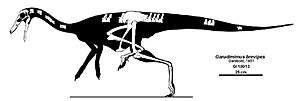 | ||
| S. galbinensis | Amtgai - Khara Khutul, Ömnögovi Province |
Upper and Lower Bayan Shireh |
"Three specimens, including mandible, pelvis, hindlimb, scapulocoracoid, incomplete forelimb, and fragmentary vertebrae."[33][28] |
A therizinosaur. |
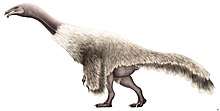 | |
|
Unnamed Caenagnathid |
Indeterminate | Tsagan Teg |
Upper Bayan Shireh |
"Partial lower jaw, similar to Gigantoraptor."[34] |
An oviraptorosaur. |
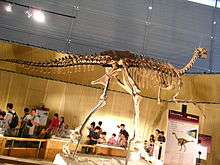 |
|
Unnamed Therizinosaur |
Indeterminate | Ulribe Khuduk |
Upper Bayan Shireh |
"Forelimbs with two digits, partial pelvis and vertebrae."[35] |
A therizinosaur. |
 |
|
Unnamed Velociraptorine |
Indeterminate | Shine Us Khuduk - Tel Ulan Chaltsai |
Upper and Lower Bayan Shireh |
"Fragmentary crania and postcrania from two specimens."[36][37][38] |
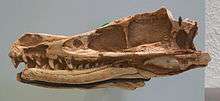 | |
Ornithischians
| Ornithischians reported from the Bayan Shireh Formation | ||||||
|---|---|---|---|---|---|---|
| Genus | Species | Location | Stratigraphic Position | Material | Notes | Images |
|
A. gobiensis |
Amtgai, Ömnögovi Province |
Upper Bayan Shireh |
"Nearly complete frontoparietal dome."[39] |
A basal pachycephalosaurid. |
||
|
A. magnus |
"Fragmentary skull." |
Reclassified as Bissektipelta archibaldi and nomen dubium.[40] |  | |||
|
G. mongoliensis |
Sheeregeen Gashoon |
Upper Bayan Shireh |
"Partial skull and postcrania."[41] |
A basal neoceratopsian. |
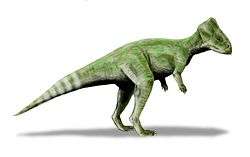 | |
|
G. mongoliensis |
Bayshin Tsav, Ömnögovi Province |
Upper Bayan Shireh |
"Multiple specimens with virtually complete skull and postcranial remains".[18][10] |
A basal hadrosauroid. |
||
|
M. disparoserratus |
"Partial skull" |
|||||
|
M. gobiensis |
"Partial skull and postcrania." |
Reclassified as Graciliceratops mongoliensis and nomen dubium.[43][41] | ||||
|
T. plicatospineus |
Bayshin Tsav, Ömnögovi Province |
Upper Bayan Shireh |
"More than five specimens, including partial skulls, nearly complete skeleton, osteoderms."[44][45][46][47][20] |
An ankylosaur. |
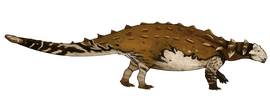 | |
|
T. longicranialis |
Tsagan Teg, Dornogovi Province |
Upper Bayan Shireh |
An ankylosaur. |
|||
|
Unnamed Hadrosauroid |
Indeterminate |
Baynshire - Char Teeg |
Upper Bayan Shireh |
"Partial right dentary and sparce postcranial remains."[10] |
A basal hadrosauroid. |
|
Sauropods
| Sauropods reported from the Bayan Shireh Formation | ||||||
|---|---|---|---|---|---|---|
| Genus | Species | Location | Stratigraphic Position | Material | Notes | Images |
| E. ellisoni | Bor Guvé, Dornogovi Province |
Upper Bayan Shireh |
"Vertebrae and postcrania."[22] |
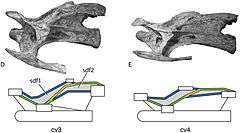 | ||
|
Unnamed Titanosaur |
Indeterminate |
Bor Guvé, Dornogovi Province |
Upper Bayan Shireh |
"Vertebrae."[49] |
A titanosaur. |
|
Other reptiles
Turtles
| Turtles reported from the Bayan Shireh Formation | ||||||
|---|---|---|---|---|---|---|
| Genus | Species | Location | Stratigraphic Position | Material | Notes | Images |
|
Charitonyx |
C. tajanikolaevae | Khara Khutul, Dornogovi Province |
Lower Bayan Shireh |
|||
|
Gobiapalone |
G. orlovi | Burkhant - Baynshire - Khongil Tsav, Dornogovi Province |
Upper Bayan Shireh |
"Crania and postcrania."[11] |
A trionychid. |
|
|
Hanbogdemys |
H. orientalis | Khara Khutul, Dornogovi Province |
Lower Bayan Shireh |
"Fragmented cervical remains."[51] |
||
|
Kharakhutulia |
K. kalandadzei | Khara Khutul, Dornogovi Province |
Lower Bayan Shireh |
"Fragmented postcrania."[51] |
||
|
Kirgizemys sp. |
Indeterminate | Khara Khutul, Dornogovi Province |
Lower Bayan Shireh |
"Fragmented postcrania."[51] |
||
|
Kizylkumemys |
K. schultzi | Khara Khutul, Dornogovi Province |
Lower Bayan Shireh |
|||
|
Lindholmemys |
L. martinsoni | Sheeregeen Gashoon - Usheen Khuduk |
Upper Bayan Shireh |
"Fragmentary shell."[53] |
||
|
"Trionyx" |
T. baynshirensis | Baynshire, Dornogovi Province |
Upper Bayan Shireh |
"Fragmentary shell."[11] |
A trionychine. |
|
Crocodylomorphs
| Crocodylomorphs reported from the Bayan Shireh Formation | ||||||
|---|---|---|---|---|---|---|
| Genus | Species | Location | Stratigraphic Position | Material | Notes | Images |
| P. gradilifrons | Sheeregeen Gashoon |
Upper Bayan Shireh |
||||
| P. major | Sheeregeen Gashoon |
Upper Bayan Shireh |
"Fragmentary crania."[56][55] | A paralligatorid. | ||
|
Unnamed crocodylomorph ichnotaxon |
Indeterminate |
Baynshire, Dornogovi Province |
Upper Bayan Shireh |
"Swim tracks."[17] |
Tracks made underwater by a swimming individual. | |
Pterosaurs
| Pterosaurs reported from the Bayan Shireh Formation | ||||||
|---|---|---|---|---|---|---|
| Genus | Species | Location | Stratigraphic Position | Material | Notes | Images |
|
Azhdarchidae spp. |
Indeterminate | Bayshin Tsav, Ömnögovi Province − Burkhant, Dornogovi Province |
Upper Bayan Shireh |
"Cervical vertebrae."[57] |
An azhdarchid. |
|
Mammals
Deltatheroidans
| Deltatheroidans reported from the Bayan Shireh Formation | ||||||
|---|---|---|---|---|---|---|
| Genus | Species | Location | Stratigraphic Position | Material | Notes | Images |
| T. dashzevegi | Tsagan Tsonj |
Lower Bayan Shireh |
"Partial left dentary."[21] |
|||
Fish
Sharks
| Sharks reported from the Bayan Shireh Formation | ||||||
|---|---|---|---|---|---|---|
| Genus | Species | Location | Stratigraphic Position | Material | Notes | Images |
| H. kansaiensis | Bayshin Tsav, Ömnögovi Province |
Upper Bayan Shireh |
"Teeth and postcrania."[8] |
A hybodontid. |
| |
|
Osteichthyes spp. |
Indeterminate |
Upper Bayan Shireh |
"Postcrania."[8] |
Bony fish. |
||
Flora
| Flora reported from the Bayan Shireh Formation | ||||||
|---|---|---|---|---|---|---|
| Genus | Species | Location | Stratigraphic Position | Material | Notes | Images |
|
Bothrocaryum |
B. gobience |
Khara Khutul, Dornogovi Province |
Lower Bayan Shireh |
"Unspecified material."[58] |
A cornacean. |
|
|
Nyssoidea |
N. mongolica |
Khara Khutul, Dornogovi Province |
Lower Bayan Shireh |
"Unspecified material."[58] |
A cornacean. |
|
|
Angiosperm spp. |
Indeterminate |
Bor Guvé - Khara Khutul, Dornogovi Province |
Upper and Lower Bayan Shireh |
Very abundant at Bor Guvé. | ||
See also
- List of dinosaur-bearing rock formations
- List of Asian dinosaurs
- Laurasia
- Geology of Mongolia
- Cretaceous Mongolia
References
- Vasiliev, V. G.; Volkhonin, V. C.; Grishin, G. L.; Ivanov, A. Kh.; Marinov, I. A.; Mokshancev, K. B. (1959). Geological structure of the People's Republic of Mongolia (stratigraphy and tectonics). p. 492.
- Watabe, M.; Suzuki, S. (2000). "Report on the Japan - Mongolia Joint Paleontological Expedition to the Gobi desert, 1994". Hayashibara Museum of Natural Sciences, Research Bulletin. 1: 30−44.
- Sochava, A. V. (1975). "Stratigraphy and lithology of the Upper Cretaceous sediments in southern Mongolia. In Stratigraphy of Mesozoic sediments of Mongolia". Transactions of Joint Soviet–Mongolian Scientific Research and Geological Expedition. 13: 113–182.
- Martinson, G. G. (1982). "The Upper Cretaceous mollusks of Mongolia". Sovmestnaya Sovetsko– Mongolskaya Paleontolog-icheskaya Ekspeditsia. 17: 5–76.
- Jerzykiewicz, T.; Russell, D. A. (1991). "Late Mesozoic stratigraphy and vertebrates of the Gobi Basin". Cretaceous Research. 12 (4): 345–377. doi:10.1016/0195-6671(91)90015-5.
- Hicks, J. F.; Brinkman, D. L.; Nichols, D. J.; Watabe, M. (1999). "Paleomagnetic and palynologic analyses of Albian to Santonian strata at Bayn Shireh, Burkhant, and Khuren Dukh, eastern Gobi Desert, Mongolia". Cretaceous Research. 20 (6): 829−850. doi:10.1006/cres.1999.0188.
- Ishigaki, S.; Tsogtbaatar, K.; Saneyoshi, M.; Mainbayar, B.; Aoki, K.; Ulziitseren, S.; Imayama, T.; Takahashi, A.; Toyoda, S.; Bayardorj, C.; Buyantegsh, B.; Batsukh, J.; Purevsuren, B.; Asai, H.; Tsutanaga, S.; Fujii, K. (2016). "Report of the Okayama University of Science - Mongolian Institute of Paleontology and Geology Joint Expedition in 2016" (PDF). Bulletin of Research Institute of Natural Sciences (42): 33−46.
- Averianov, A.; Sues, H. (2012). "Correlation of Late Cretaceous continental vertebrate assemblages in Middle and Central Asia" (PDF). Journal of Stratigraphy. 36 (2): 462–485.
- Samoilov, V. S.; Benjamini, C. (1996). "Geochemical features of dinosaur remains from the Gobi Desert, South Mongolia". PALAIOS. 11 (6): 519–531. doi:10.2307/3515188. JSTOR 3515188.
- Slowiak, J.; Szczygielski, T.; Ginter, M.; Fostowicz-Frelik, L. (2020). "Uninterrupted growth in a non‐polar hadrosaur explains the gigantism among duck‐billed dinosaurs". Paleontology. doi:10.1111/pala.12473.
- Danilov, I. G.; Hirayama, R.; Sukhanov, V. B.; Suzuki, S.; Watabe, M.; Vitek, N. S. (2014). "Cretaceous soft-shelled turtles (Trionychidae) of Mongolia: new diversity, records and a revision". Journal of Systematic Palaeontology. 12 (7): 799–832. doi:10.1080/14772019.2013.847870.
- Kurumada, Y.; Aoki, S.; Aoki, K.; Kato, D.; Saneyoshi, M.; Tsogtbaatar, K.; Windley, B. F.; Ishigaki, S. (2020). "Calcite U–Pb age of the Cretaceous vertebrate‐bearing Bayn Shire Formation in the Eastern Gobi Desert of Mongolia: usefulness of caliche for age determination". Terra Nova. doi:10.1111/ter.12456.
- Currie, P. J.; Eberth, D. A. (1993). "Palaeontology, sedimentology and palaeoecology of the Iren Dabasu Formation (Upper Cretaceous), Inner Mongolia, People's Republic of China". Cretaceous Research. 14 (2): 127−144. doi:10.1006/cres.1993.1011.
- Nessov, L. A. (1995). Dinosaurs of northern Eurasia: new data about assemblages, ecology and paleobiogeography (in Russian). Saint Petersburg: Saint Petersburg University. p. 156. Translated paper
- Averianov, A. O. (2002). "An ankylosaurid (Ornithischia: Ankylosauria) braincase from the Upper Cretaceous Bissekty Formation of Uzbekistan" (PDF). Bulletin de l'Institut Royal des Sciences Naturelles de Belgique Sciences de la Terre. 72: 97−100.
- Van Itterbeeck, J.; Horne, D. J.; Bultynck, P.; Vandenberghe, N. (2005). "Stratigraphy and palaeoenvironment of the dinosaur-bearing Upper Cretaceous Iren Dabasu Formation, Inner Mongolia, People's Republic of China". Cretaceous Research. 26 (4): 699–725. doi:10.1016/j.cretres.2005.03.004.
- Lee, Y. M.; Lee, H. J.; Kobayashi, Y.; Carabajal, A. P.; Barsbold, R.; Fiorillo, A. R.; Tsogtbaatar, K. (2019). "Unusual locomotion behaviour preserved within a crocodyliform trackway from the Upper Cretaceous Bayanshiree Formation of Mongolia and its palaeobiological implications". Palaeogeography, Palaeoclimatology, Palaeoecology. 533 (109353): 2. doi:10.1016/j.palaeo.2019.109239.
- Tsogtbaatar, K.; Weishampel, D. B.; Evans, D. C.; Watabe, M. (2019). "A new hadrosauroid (Dinosauria: Ornithopoda) from the Late Cretaceous Baynshire Formation of the Gobi Desert (Mongolia)". PLOS ONE. 14 (4): e0208480. Bibcode:2019PLoSO..1408480T. doi:10.1371/journal.pone.0208480. PMC 6469754. PMID 30995236.
- Zanno, L.E.; Tsogtbaatar, K.; Chinzorig, T.; Gates, T.A. (2016). "Specializations of the mandibular anatomy and dentition of Segnosaurus galbinensis (Theropoda: Therizinosauria)". PeerJ. 4: e1885. doi:10.7717/peerj.1885. PMC 4824891. PMID 27069815.
- Park, J. Y.; Lee, Y. N.; Currie, P. J.; Kobayashi, Y.; Koppelhus, E.; Barsbold, R.; Mateus, O.; Lee, S.; Kim, S. H. (2019). "Additional skulls of Talarurus plicatospineus (Dinosauria: Ankylosauridae) and implications for paleobiogeography and paleoecology of armored dinosaurs". Cretaceous Research. 108: 104340. doi:10.1016/j.cretres.2019.104340.
- Rougier, G. W.; Davis, B. M.; Novacek, M. J. (2015). "A deltatheroidan mammal from the Upper Cretaceous Baynshiree Formation, eastern Mongolia". Cretaceous Research. 52: 167–177. doi:10.1016/j.cretres.2014.09.009.
- Ksepka, D. T.; Norell, M. A. (2006). "Erketu ellisoni, a long-necked sauropod from Bor Guvé (Dornogov Aimag, Mongolia)" (PDF). American Museum Novitates. 3508 (3508): 1–16. doi:10.1206/0003-0082(2006)3508[1:EEALSF]2.0.CO;2.
- Perle, A.; Norell, M. A.; Clark, J. (1999). "A new maniraptoran Theropod−Achillobator giganticus (Dromaeosauridae)−from the Upper Cretaceous of Burkhant, Mongolia". Contributions from the Geology and Mineralogy Chair, National Museum of Mongolia (101): 1–105. OCLC 69865262.
- Perle, A. (1977). "O pervoy nakhodke Alektrozavra (Tyrannosauridae, Theropoda) iz pozdnego Mela Mongolii" [On the first discovery of Alectrosaurus (Tyrannosauridae, Theropoda) in the Late Cretaceous of Mongolia]. Shinzhlekh Ukhaany Akademi Geologiin Khureelen (in Russian). 3 (3): 104–113.
- Ariunchimeg, Y. (1997). "Results of studies of dinosaur eggs". Mongolia–Japan Joint Paleontological Expedition. Abstract of Report Meeting: 13.
- Watabe, M.; Ariunchimeg, Y.; Brinkman, D. (1997). "Dinosaur egg nests and their sedimentary environments in the Bayn Shire locality (Late Cretaceous), eastern Gobi". Mongolia–Japan Joint Paleontological Expedition. Abstract of Report Meeting: 11.
- Barsbold, R. (1983). "Carnivorous Dinosaurs from the Cretaceous of Mongolia" (PDF). Transactions of the Joint Soviet-Mongolian Paleontological Expedition. 19: 89.
- Barsbold, R.; Perle, A. (1980). "Segnosauria, a new infraorder of carnivorous dinosaurs" (PDF). Acta Palaeontologica Polonica. 25 (2): 187–195.
- Perle, A. (1981). "Novyy segnozavrid iz verkhnego mela Mongolii" [New Segnosauridae from the Upper Cretaceous of Mongolia] (PDF). Transactions of the Joint Soviet-Mongolian Paleontological Expedition (in Russian). 15: 50–59.
- Barsbold, R. (1981). "Toothless carnivorous dinosaurs of Mongolia". Transactions, Joint Soviet–Mongolian Palaeontological Expedition. 15: 28–39. S2CID 195060070.
- Kobayashi, Y.; Barsbold, R. (2005). "Reexamination of a primitive ornithomimosaur, Garudimimus brevipes Barsbold, 1981 (Dinosauria: Theropoda), from the Late Cretaceous of Mongolia". Canadian Journal of Earth Sciences. 42 (9): 1501–1521. doi:10.1139/e05-044. hdl:2115/14579.
- Cuff, A. R.; Rayfield, E. J. (2015). "Retrodeformation and muscular reconstruction of ornithomimosaurian dinosaur crania". PeerJ. 3: e1093. doi:10.7717/peerj.1093. PMID 26213655.
- Perle, A. (1979). "Segnosauridae - a new family of theropods from the Late Cretaceous of Mongolia" (PDF). Sovmestnaya Sovetsko-Mongol'skaya Paleontologicheskaya Ekspeditsiya. 8: 45–55.
- Tsuihiji, T.; Watabe, M.; Barsbold, R.; Tsogtbaatar, K. (2015). "A gigantic caenagnathid oviraptorosaurian (Dinosauria: Theropoda) from the Upper Cretaceous of the Gobi Desert, Mongolia". Cretaceous Research. 56: 60–65. doi:10.1016/j.cretres.2015.03.007.
- Kobayashi, Y.; Chinzorig, T.; Tsogtbaatar, K.; Barsbold, R. (2015). "A new therizinosaur with functionally didactyl hands from the Bayanshiree Formation (Cenomanian-Turonian), Omnogovi Province, southeastern Mongolia" (PDF). Journal of Vertebrate Paleontology. Program and Abstracts. Photographs
- Kubota, K.; Barsbold, R. (2007). "New dromaeosaurid (Dinosauria Theropoda) from the Upper Cretaceous Bayanshiree Formation of Mongolia". Journal of Vertebrate Paleontology. 27 (suppl. to 3): 102A. doi:10.1080/02724634.2007.10010458.
- Turner, A. H.; Makovicky, P. J.; Norell, M. A. (2012). "A Review of Dromaeosaurid Systematics and Paravian Phylogeny". Bulletin of the American Museum of Natural History. 371 (371): 19–20. doi:10.1206/748.1.
- Kubota, K. (2015). "Descriptions of Mongolian Dromaeosaurids (Dinosauria: Theropoda) and phylogeny of Dromaeosauridae". PHD Dissertation (in Japanese).
- Watabe, M.; Tsogtbaatar, K.; Sullivan, R. M. (2011). "A new pachycephalosaurid from the Baynshire Formation (Cenomanian-late Santonian), Gobi Desert, Mongolia" (PDF). Fossil Record 3. New Mexico Museum of Natural History and Science, Bulletin. 53: 489–497.
- Parish, J. C.; Barrett, P. M. (2004). "A reappraisal of the ornithischian dinosaur Amtosaurus magnus Kurzanov and Tumanova 1978, with comments on the status of A. archibaldi Averianov 2002". Canadian Journal of Earth Sciences. 41 (3): 299–306. doi:10.1139/e03-101.
- Sereno, P. C. (2000). "The fossil record, systematics and evolution of pachycephalosaurs and ceratopsians from Asia". The Age of Dinosaurs in Russia and Mongolia (PDF). Cambridge University Press. p. 489–491.
- Arbour, V. M. (2014). Systematics, evolution, and biogeography of the ankylosaurid dinosaurs (PDF) (PhD thesis). p. 265.
- Maryańska, T.; Osmólska, H. (1975). "Protoceratopsidae (Dinosauria) of Asia" (PDF). Palaeontologia Polonica. 33: 134–143.
- Maleev, E. A. (1952). "New ankylosaur of the Upper Cretaceous of Mongolia". Doklady Akademii Nauk SSSR. 87: 273–276.
- Tumanova, T. A. (1987). "The armored dinosaurs of Mongolia". The Joint Soviet Mongolian Paleontological Expedition Transaction. 32: 1–76.
- Tumanova, T. A. (2000). "Armoured dinosaurs from the Cretaceous of Mongolia". The Age of Dinosaurs in Russia and Mongolia. Cambridge University Press. p. 517–532.
- Arbour, V. M.; Currie, P. J. (2016). "Systematics, phylogeny and palaeobiogeography of the ankylosaurid dinosaurs". Journal of Systematic Palaeontology. 14 (5): 385–444. doi:10.1080/14772019.2015.1059985.
- Tumanova, T. A. (1993). "A new armored dinosaur from Southeastern Gobi". Paleontologicheskii Zhurnal. 27: 92–98.
- Ksepka, D.; Norell, M. A. (2010). "The Illusory Evidence for Asian Brachiosauridae: New Material of Erketu ellisoni and a Phylogenetic Reappraisal of Basal Titanosauriformes" (PDF). American Museum Novitates. 3700 (3700): 1–27. doi:10.1206/3700.2.
- Chkhikvadze, V. M. (1980). "On the question of the origin of the soft−shelled turtles". Bulletin of the Academy of Sciences of the Georgian SSR. 100 (2): 501–503.
- Sukhanov, V. B.; Danilov, I. G.; Syromyatnikova, E. V. (2008). "The Description and Phylogenetic Position of a New Nanhsiungchelyid Turtle from the Late Cretaceous of Mongolia". Acta Palaeontologica Polonica. 53 (4): 601–614. doi:10.4202/app.2008.0405.
- Nessov, L. A. (1981). "Herpetological Investigations in Siberia and the Far East". On the turtle of the family Dermatemydidae from the Cretaceous of Amur River Basin and some other rare findings of remains of ancient turtles of Asia. pp. 69–73.
- Danilov, I. G.; Sukhanov, V. B. (2001). "New data on lindholmemydid turtle Lindholmemys from the Late Cretaceous of Mongolia" (PDF). Acta Palaeontologica Polonica. 46 (1): 125–131.
- Konzhukova, E. D. (1954). "New fossil crocodilian from Mongolia". Trudy Paleontologicheskogo Instituta. 48: 171–194.
- Turner, A. H. (2015). "A Review of Shamosuchus and Paralligator (Crocodyliformes, Neosuchia) from the Cretaceous of Asia". PLOS ONE. 10 (2): e0118116. doi:10.1371/journal.pone.0118116. PMID 25714338.
- Efimov, M. B. (1981). "New paralligatorids from the Upper Cretaceous of Mongolia". Trudy Sovmestnoi Sovetsko-Mongol'skoi Paleontologicheskoi Ekspeditsii. 15: 26–28.
- Watabe, M.; Suzuki, D.; Tsogtbaatar, K. (2009). "The first discovery of pterosaurs from the Upper Cretaceous of Mongolia" (PDF). Acta Palaeontologica Polonica. 54 (2): 231–242. doi:10.4202/app.2006.0068.
- Khand, Y.; Badamgarav, D.; Ariunchimeg, Y.; Barsbold, R. (2000). "Cretaceous system in Mongolia and its depositional environments". Cretaceous Environments of Asia. Developments in Palaeontology and Stratigraphy. 17. pp. 49–79. doi:10.1016/s0920-5446(00)80024-2. ISBN 9780444502766.
